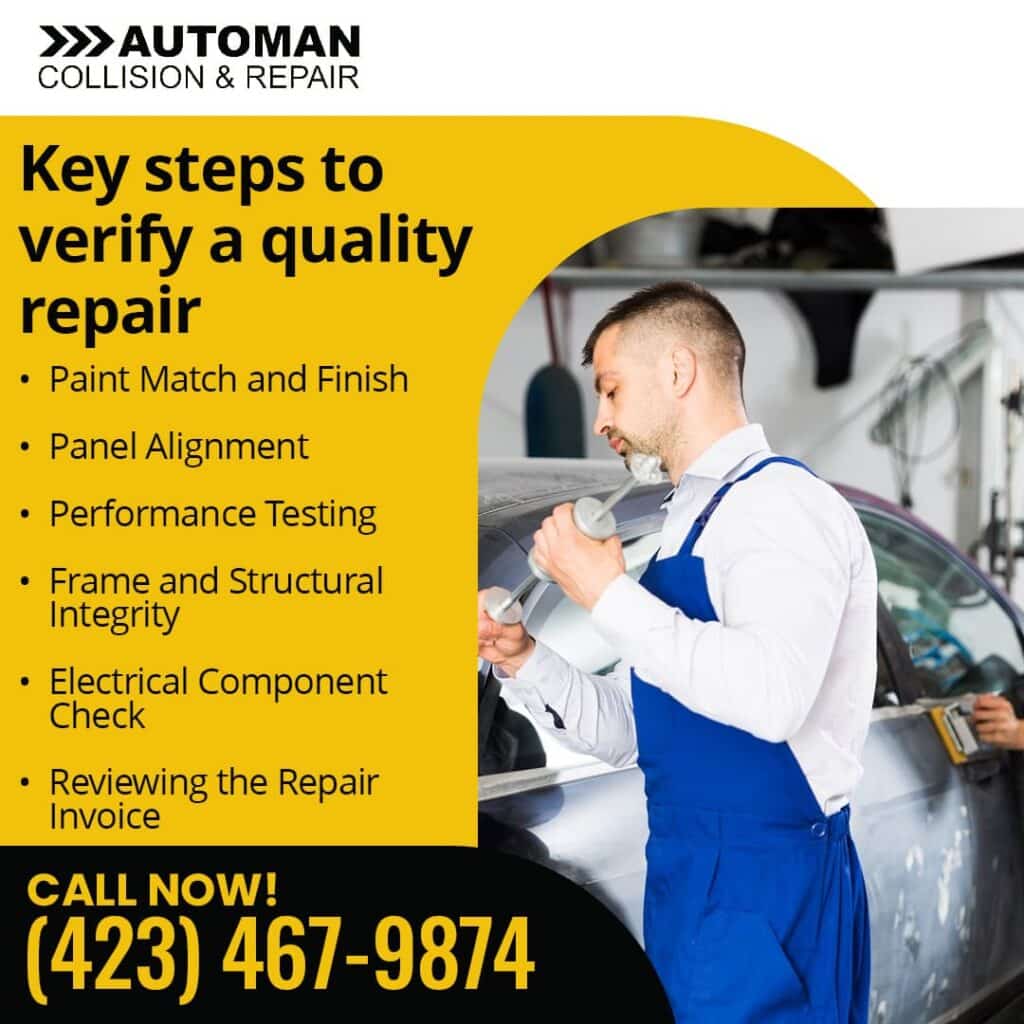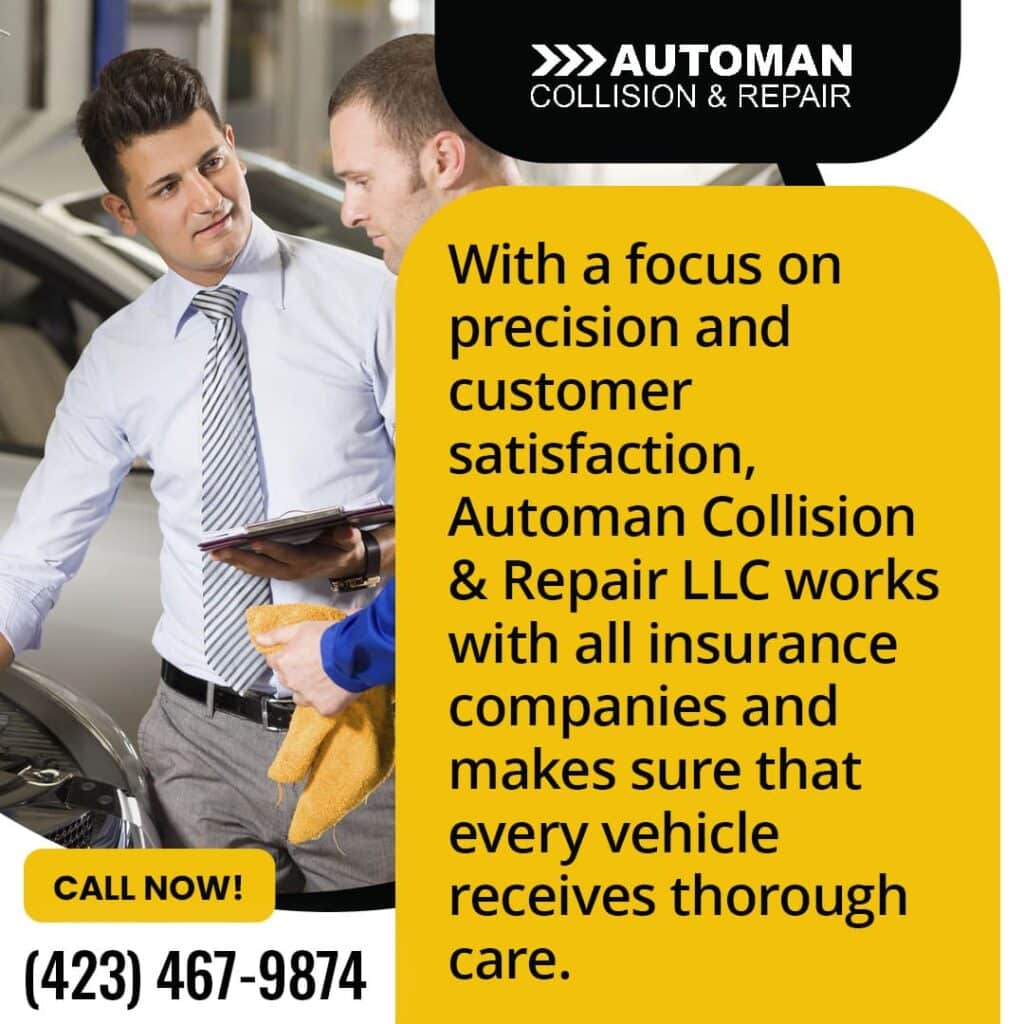Vehicle owners in Johnson City, TN, depend on their cars for daily transportation, making proper collision repair essential for safety and longevity. A poorly executed repair can lead to hidden structural damage, misaligned panels, or malfunctioning safety features, putting drivers and passengers at risk. Without a thorough inspection, issues like improper paint matching, faulty airbag systems, or miscalibrated sensors may go unnoticed until they cause further complications.
At Automan Collision & Repair LLC, we recognize the concerns vehicle owners have when seeking collision repair nearby. Trusting the wrong auto body collision shops near you can result in substandard work that affects vehicle performance and resale value. This guide outlines the key factors every driver should check to confirm their collision repair in Johnson City, TN, was done correctly, providing both safety and long-term reliability.
Key Takeaways
- Thoroughly inspect your vehicle after repairs – Check for proper paint matching, panel alignment, and smooth functionality to confirm high-quality collision repair in Johnson City, TN.
- Verify safety system functionality – Airbags, sensors, and cameras should be fully operational after auto collision repair to maintain vehicle safety.
- Check for structural integrity and alignment – A properly repaired frame guarantees smooth handling and helps prevent long-term issues following collision repair.
- Review repair documentation and warranties – Reliable auto collision shops provide detailed invoices and workmanship guarantees for added transparency.
- Take a test drive to detect potential issues – The drive performance should feel normal after repairs at auto body collision shops.

Inspect the Paint and Finish
The paint should match seamlessly with the rest of the vehicle. A flawless paint job indicates meticulous work. Examine for:
- Uniform Color: The repaired section should blend with the original paint under different lighting conditions.
- Consistent Texture: The finish should feel smooth, free from rough patches or excessive orange peel.
- Clean Edges: There should be no paint overspray on windows, trim, or adjacent panels.
Example: Imagine a car with a repaired rear quarter panel. If the new paint appears slightly darker under sunlight or has a rough texture, it could indicate an improper paint match or application.
Verify Panel Alignment
Repaired panels should align properly with surrounding bodywork. Misalignment can indicate incomplete or incorrect repairs. Check for:
- Even Gaps: The spacing between panels should be symmetrical and match factory specifications.
- Proper Fitment: Doors, hood, and trunk should sit flush without sticking out or sitting too deep.
- Smooth Opening and Closing: All panels should function without resistance or misalignment.
Example: Suppose a vehicle’s front fender was replaced after a minor collision. If the hood now appears slightly raised on one side or the door scrapes against the fender when opening, the panel alignment needs adjustment.
Assess Structural Integrity
The vehicle’s frame should be restored to its original specifications. A compromised structure can affect safety and drivability. Look for:
- Straight Frame: The vehicle should drive straight without pulling to one side.
- No Unusual Noises: There shouldn’t be any creaks, rattles, or vibrations when driving.
- Proper Wheel Alignment: The steering wheel should be centered, and the tires should wear evenly.
According to a study presented at the Collision Industry Conference, over 50% of inspected vehicles had moderate to severe frame issues that were not properly corrected.
Confirm the Functionality of Safety Systems
All safety features should be operational post-repair. Malfunctioning systems can put occupants at risk. Verify:
- Airbag System: The airbag light should not be on, indicating a successful reset.
- Sensors and Cameras: Features like lane departure warnings and backup cameras should function properly.
- Seatbelt Mechanisms: Seatbelts should retract and latch securely without hesitation.
Examine the Quality of Replacement Parts
High-quality parts should be used for replacements. Inferior parts can impact vehicle performance and safety. Consider:
- Seamless Fitment: Replacement parts should align perfectly without modifications.
- Longevity and Durability: High-quality parts provide long-term reliability.
At Automan Collision & Repair LLC, we prioritize using the best quality parts whenever possible to maintain the integrity of your vehicle.
Review Documentation and Warranties
Detailed repair documentation provides transparency and accountability. You should receive:
- Detailed Repair Invoice: A breakdown of the services performed and parts used.
- Warranty Coverage: Protection for workmanship and replacement parts.
- Inspection Reports: A summary of pre- and post-repair assessments.
A reputable auto body collision shop will stand behind its work with warranties, giving you confidence in the repairs performed. At Automan Collision & Repair LLC, we provide a lifetime repair warranty.
Take a Test Drive
A test drive can help identify lingering issues. Pay attention to:
- Steering Response: The vehicle should steer normally without drifting or pulling.
- Brake Functionality: Brakes should feel firm and responsive without vibrations.
- Performance: The ride should be smooth, with no unusual noises or stiffness.
Check for Diagnostic Trouble Codes (DTCs)
Modern vehicles store error codes when systems malfunction. A post-repair scan can reveal any unresolved issues. Make sure:
- No Active DTCs: There should be no lingering error codes.
- Historical Codes Resolved: Past issues should be addressed and cleared.
- No Warning Lights: The dashboard should not display check engine or system malfunction alerts.
A 2023 survey reported that 85% of shops perform pre-repair scans on “all” or “most” vehicles, an increase from 79% in 2020, and 93% conduct post-repair scans on “all” or “most” vehicles, up from 88% in 2020.
Confirm Proper Calibration of Advanced Driver-Assistance Systems (ADAS)
ADAS features require precise calibration post-repair. Misaligned sensors can cause malfunctioning safety systems. Verify:
- Lane Departure Warning: Alerts should activate properly when drifting.
- Adaptive Cruise Control: The system should maintain safe following distances without abrupt braking.
- Automatic Emergency Braking: The feature should engage when detecting obstacles.
A recent Forbes article emphasized the risks associated with improper repairs requiring calibrations, noting that improperly repaired ADAS can increase accident risk, give drivers a false sense of security, and create liability concerns for repair shops and vehicle owners.
Example: Imagine a vehicle had its front bumper replaced, affecting the sensors. If the automatic emergency braking no longer activates when approaching obstacles, the ADAS system may require recalibration.
Common Post-Repair Issues to Watch For
Even quality repairs can sometimes have minor issues. Be aware of:
- Dashboard Warning Lights: Could indicate unresolved sensor or system errors.
- Inconsistent Paint Matching: May suggest improper blending or color mismatch.
- Unusual Sounds While Driving: Can signal loose parts or improper assembly.
- Water Leaks Inside the Car: A sign of faulty weather stripping or poor sealing.
- Misaligned Body Panels: Gaps or uneven surfaces can indicate incomplete structural work.
If any of these issues arise, return to the shop for an inspection and necessary corrections.
The Importance of a Post-Repair Inspection
A post-repair inspection verifies that all work meets industry standards. Key areas to check include:
- Structural Integrity: Makes sure the frame and body are properly restored.
- Safety Systems: Confirms that all airbags, seatbelts, and electronic features are functioning.
- Exterior and Paint Quality: Confirms the finish meets manufacturer specifications.
National Highway Traffic Safety Administration (NHTSA) emphasizes the importance of vehicle crashworthiness—the ability of a vehicle to protect its occupants during an impact. Proper maintenance and repairs are essential to make sure that a vehicle’s safety features function as intended.
Collision Repair Near You: Final Quality Check Before Pickup
At Automan Collision & Repair LLC, before returning your vehicle, we perform a detailed inspection to confirm that all repairs meet our standards. Every part is checked to make sure your car is both safe and fully functional.
Quality Check Process:
- Thorough Inspection: We verify that every clip, screw, and component is in place. Nothing is overlooked.
- Test Drive: We check handling, alignment, braking, and overall performance on the road.
- Electronic Diagnostics: A full system scan confirms all onboard features and safety systems are working correctly.
- Final Cleaning: We wash and inspect the vehicle, removing dust and debris for a polished look.
- Customer Review: If you have any questions, our team is happy to explain the work completed.
Our goal is to return your vehicle in excellent condition. By following this process, we help maintain both the safety and performance of your car. If you’re looking for auto collision repair near you, our team is committed to delivering high-quality repairs with attention to detail.

Frequently Asked Questions (FAQs) – Automan Collision & Repair LLC
How can I tell if my collision repair was done correctly?
At Automan Collision & Repair LLC, we restore vehicles to their original condition. Check for even panel gaps, smooth paint matching, and properly functioning safety features. Post-repair inspections are done to confirm the quality of our collision repair in Johnson City, TN.
What should I do if I notice issues after my repair?
If you experience misaligned panels, paint defects, or any concerns, bring your vehicle back to us. Our team stands behind every auto collision repair we do. We will make any necessary adjustments to meet our high-quality standards.
Are all replacement parts the same quality?
No. At Automan Collision & Repair LLC, we prioritize using the highest quality parts to maintain safety and performance. We make sure that every part fits seamlessly and meets factory specifications for collision repair near you.
Why is a test drive important after a collision repair?
A test drive can reveal hidden issues, such as steering misalignment or unusual noises. We encourage customers to take their repaired vehicles for a drive and return to our auto collision shop nearby if anything feels off.
Do you provide warranties on collision repairs?
Yes, we provide lifetime warranties on our repair work to give customers peace of mind. Our team at Automan Collision & Repair LLC takes pride in delivering high-quality repairs, and we stand by every collision repair in Johnson City, TN.
Final Thoughts
Confirming your car’s collision repair was done right protects both its value and safety. At Automan Collision & Repair LLC in Johnson City, TN, we take pride in delivering precise, high-quality repairs. Whether you need auto collision repair nearby or are searching for auto body collision shops near you, we are committed to restoring your vehicle to its best condition.
For collision repair near you in Johnson City, trust Automan Collision & Repair LLC—where quality and safety come first. Contact us today by calling (423) 467-9874 or emailing [email protected] to schedule a free inspection!
